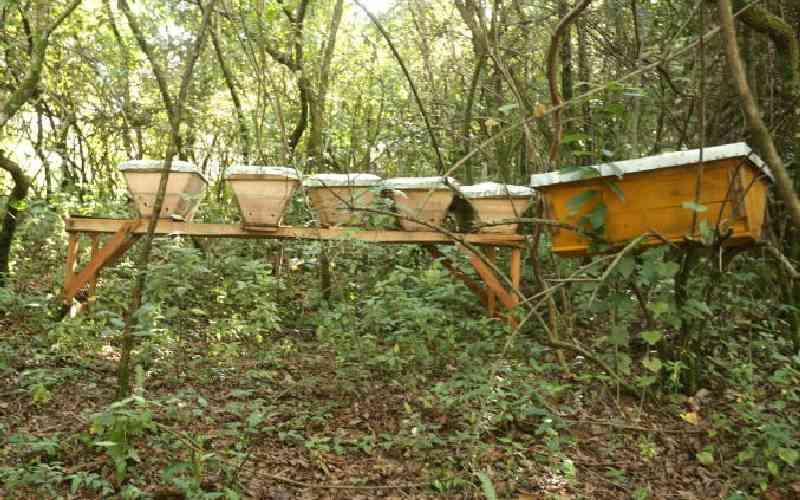
Tour guide Gerald Amutebi during interview at Kampi ya Lucki camp site resort at Kakamega. [Benjamin Sakwa, Standard]
Tucked 200 metres off the road at Kambi ya Mwanza along the Kakamega-Webuye road, lies Kampi ya Lucki, one of the few natural habitats in Western Kenya.
Lucki is a six-acre piece of land on which indigenous trees, rare species of birds, snakes, civet cats and an expansive, uniquely formed rock are found.
Some indigenous tree species served specific purposes among the Luhya community. Some were valued for their medicinal properties, which put them at risk of extinction for being highly sought after.
Others were good for firewood, while others were used for rites.
"We have made a point of preserving most of these trees because they have medicinal value and are central to our customs," explains Joab Luseno, an elder.
"I used to see traditional healers frequent this place in search of herbs," recalls 80-year-old Marita Mulinga.
She also explains that elderly men would sometimes congregate in the area to perform traditional rites.
The 'Murembe' tree (Erythrina abyssinica), mystically cured mumps, a viral disease characterised by fever, malaise, headache and muscle pain accompanied by painful swelling of the glands below the jaw on either side of the neck. Children suffering from the disease were made to go around the 'magic' tree seven times while carrying pieces of firewood on their heads and making incantations.
They would then drop the firewood at the base of the tree and go home without looking back. It was believed doing so cured mumps.
"It was taboo to cut down the murembe tree and use it as firewood. Only the elderly were permitted to use it for that purpose," Luseno adds.
Another tree, the 'Shikangania' (Bridelia micrantha) can only be used as firewood during funerals and burns well even when wet.
On such occasions, a bonfire is lit at night to warm people who spend night vigils outside and also fend off mosquitoes.
Other medicinal trees like 'Musunzu' (Croton macrostachyus), 'Mulakha' (Pterocarpus angolensis) and Mutsetse (Syzygium cordatum) can be found at Kampi ya Lucki but have entirely disappeared from the villages where they once used to abound.
'Musunzu' leaves are normally dried and burned to ash then used to cure persistent cough.
On the edges of Kampi ya Lucki, a big 'Nandi flame' tree in its majesty adds to the alluring beauty of the expansive park.
A hollowed-out tree stump marks the place where our guide, Gerald Amutebi, says he has seen civet cats on several occasions.

Kampi ya Lucki camp site resort in Kakamega. [Benjamin Sakwa, Standard]
"Civet cats come out only at night. They are very secretive animals. They disappear when they sense a human presence," says Amutebi.
A civet is a small nocturnal animal whose body resembles a leopard and is native to Asia and Africa.
"In the bushes and among trees here, there are many snake species but you cannot see them during the day. Snakes normally come out in the morning to bask," Amutebi says.
The guide adds that they have planted 'king of the night', a plant that emits a smell which repels snakes.
That way, they do not come anywhere close to the grass-thatched structures in the trees.
There are many bird species in the forest, most of which are visible only in the morning and late evening.
According to Amutebi, the most interesting of the colourful birds is 'isimbishira' (Striking African Bird).
He reveals that males spends a better part of the day preening and trying to impress females. Despite its tiny size, the isimbishira is so fierce that even eagles are wary of it.
"Natives believe the bird's long tail is a potent love charm that men use to win women over," Amutebi says.
The narrow, loose-rock pathways near a traditional hut set among indigenous trees lead to an expansive rock on the Eastern side of Kampi ya Lucki.
The rock face is covered by algae due to long exposure to the elements.

One cannot miss noticing numerous straight, equidistant lines that mark symmetrical chunks of rock.
They have the appearance of building blocks held together by cement. Indeed, what looks like hardened tar forms the bond between the slabs of rock in some places.
Higher up the rock face, there is a pan with three tiny depressions above it, and another pan a few metres away.
"Men used to come and bathe at this secluded point in the evenings. These two rock pans hardly run dry. Even during the dry season, there is always water around. When the water overflows the pan, it flows down the river below," says the guide.
Makuva states that they are planting more indigenous trees to replace those that have been destroyed by human activity.
They have also placed beehives in strategic places to lure bees away from the rocks where they used to stay, so as to tame them after they became wild and a threat to visitors.
There are two log cabins, a grass thatched traditional hut, a spacious brick cabin and huts where people can relax under the shade of trees in the tranquillity of natural forest.
 The Standard Group Plc is a multi-media organization with investments in media
platforms spanning newspaper print
operations, television, radio broadcasting, digital and online services. The
Standard Group is recognized as a
leading multi-media house in Kenya with a key influence in matters of national
and international interest.
The Standard Group Plc is a multi-media organization with investments in media
platforms spanning newspaper print
operations, television, radio broadcasting, digital and online services. The
Standard Group is recognized as a
leading multi-media house in Kenya with a key influence in matters of national
and international interest.


